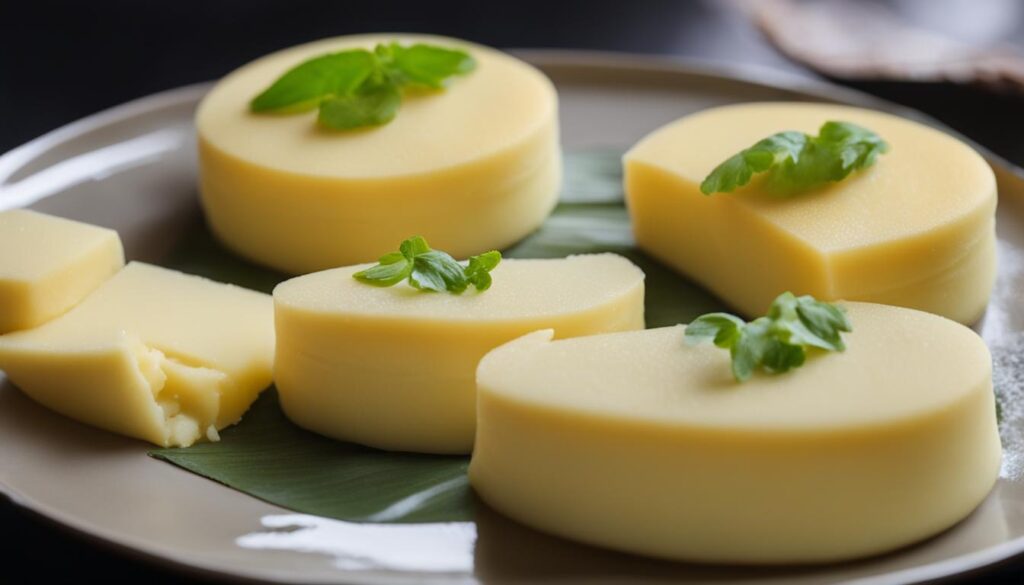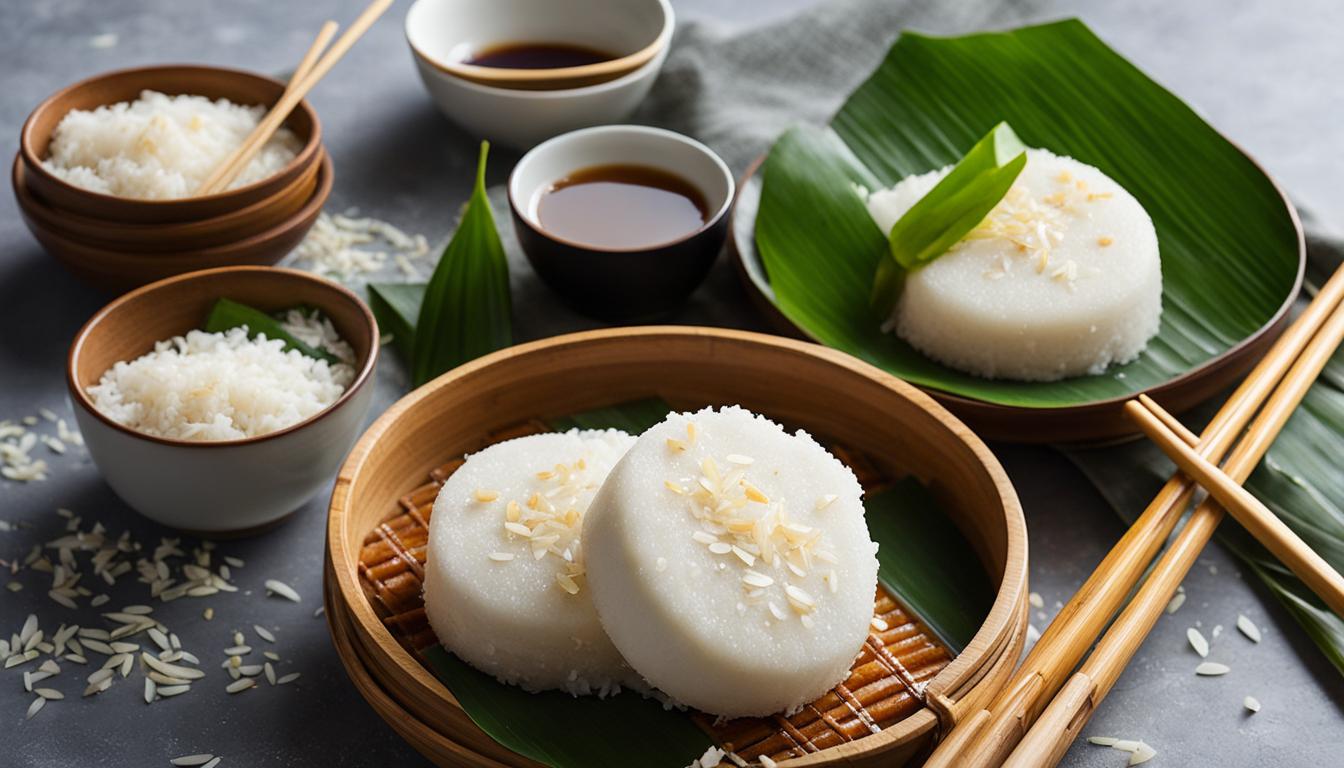Have you ever wondered how to make the perfect puto Filipino steamed rice cakes at home? It’s easier than you think!
Puto is a classic Filipino dessert that is a hit at family parties and gatherings. But what sets it apart from other Filipino desserts? And how can you achieve that light and airy texture that makes it so irresistible?
Join us as we dive into the world of puto, exploring its origins, tips and tricks for making it, and even a delicious variation that will blow your taste buds away.
Key Takeaways:
- Discover the secrets to making homemade puto Filipino steamed rice cakes.
- Learn about the origins of puto and its place in Filipino cuisine.
- Uncover tips and tricks for achieving the perfect puto texture.
- Explore a delicious variation of puto that adds a savory twist.
- Celebrate Filipino cuisine and indulge in the joy of making puto at home.
The Origins of Puto
Have you ever wondered about the origins of this delightful Filipino rice cake known as puto? The word “puto” actually comes from the Malay word “puttu,” which means “portioned.” It’s fascinating to see the etymology of puto tracing back to another language and culture.
Puto’s roots can be found in the Philippines, where it is considered a classic kakanin or rice cake. While other Filipino desserts like halo halo, leche flan, biko, bibingka, and cassava cake tend to be on the sweeter side, puto stands out for its less sweet taste. This makes it a versatile dessert that can be enjoyed with various toppings or flavors.
“Puto is often eaten as a dessert, but it can also be paired with savory dishes like dinuguan, a traditional Filipino pork blood stew. The combination of the sweet and savory flavors creates a unique culinary experience.”
With its humble and flavorful origins, puto has become a beloved treat in Filipino cuisine. Whether it’s enjoyed on its own or paired with other dishes, puto continues to captivate taste buds and bring joy to gatherings and celebrations.
Making Puto: Tips and Tricks
When it comes to making delicious puto, there are a few key tips and tricks that can help you achieve the best results. Whether you’re a seasoned cook or a beginner in the kitchen, these puto cooking tips will ensure that your steamed rice cakes turn out perfect every time. From choosing the right ingredients to mastering the steaming process, let’s dive into the secrets of making mouthwatering puto.
1. Use Rice Flour for the Perfect Texture
The choice of flour is crucial in achieving the desired texture of puto. Instead of using glutinous or sweet rice flour, opt for regular rice flour. This will give your puto a light and airy consistency that is characteristic of this Filipino delicacy.
2. Sift the Rice Flour and Baking Powder
Before mixing the batter, it’s important to sift the rice flour and baking powder together. This step helps to remove any lumps and ensures a smooth and even batter. Sifting also helps to incorporate air into the mixture, resulting in a lighter and fluffier puto.
3. Enhance the Flavor with Coconut Milk
To add a delightful flavor to your puto, include coconut milk in the batter. This tropical ingredient not only enhances the taste but also gives the rice cakes a hint of sweetness and a subtle aroma. Use fresh or canned coconut milk for the best results.
4. Opt for Silicone Mini Muffin Molds
When it comes to steaming and removing the puto, silicone mini muffin molds are a game-changer. The flexible material makes it easier to release the puto without sticking to the sides. Plus, the individual portions created by these molds are perfect for serving and enjoying.
5. Steam Over Medium Heat
Steaming the puto over medium heat is crucial to prevent overcooking or drying out. The gentle and steady heat allows the cakes to cook evenly and ensures that they remain moist and tender. Keep an eye on the cooking time, as it may vary depending on the size of your molds.
By following these puto cooking tips and tricks, you’ll be able to master the steaming process and create delectable rice cakes that are sure to impress. So gather your ingredients, prepare your batter, and get ready to indulge in the deliciousness of homemade puto.
Cheese Puto Variation
Cheese puto is a popular variation of puto that adds a savory twist to the traditional recipe. Instead of the usual sweet flavor, cheese puto incorporates the tanginess and richness of American yellow cheese. The combination of the soft and fluffy rice cake with the melted cheese on top creates a delightful contrast of textures and flavors.
When making cheese puto, the process remains the same as the traditional recipe. The only difference is the addition of cheese as a topping. Simply place a slice of American yellow cheese on each puto before steaming them. As the puto steam, the cheese will melt, creating a gooey and savory layer on top.
Aside from cheese, there are other variations of puto that you can explore. Traditional Filipino toppings include salted eggs, which add a salty and creamy element, and ube flavoring, which gives the puto a vibrant purple color and a slightly sweet taste.
Puto is a versatile dessert that can be enjoyed on its own or paired with savory flavors. The combination of sweet and savory flavors in Filipino cuisine is often celebrated, and puto offers the perfect balance for those who appreciate both. It can be served as a snack, dessert, or even as part of a main meal.
An excellent pairing for cheese puto is dinuguan, a Filipino stew made with pork blood. The rich and savory flavors of the dinuguan complement the cheesy sweetness of the puto, creating a classic combination that is beloved by many.
Try this Savory and Cheesy Puto Recipe:
Ingredients:
- 2 cups rice flour
- 1 cup sugar
- 2 tablespoons baking powder
- 1 cup coconut milk
- A pinch of salt
- American yellow cheese slices (one for each puto)
Instructions:
- In a mixing bowl, combine the rice flour, sugar, baking powder, and salt.
- Gradually add the coconut milk to the dry ingredients, stirring well to form a smooth batter.
- Place a slice of American yellow cheese on top of each puto mold.
- Pour the batter into the greased puto molds, filling each mold about ¾ full.
- Steam the puto for about 15-20 minutes or until a toothpick inserted in the center comes out clean.
- Remove the puto from the molds and let them cool slightly before serving.

Conclusion
Making puto at home is a simple and rewarding process. With the right ingredients and techniques, you can create light, airy, and delicious Filipino steamed rice cakes. Whether you prefer the traditional puto recipe or want to try variations like cheese puto, the possibilities are endless.
Puto is a versatile dessert that can be enjoyed on its own or paired with savory dishes. The homemade puto recipe allows you to customize it to suit your taste, making it the perfect treat for any occasion. From family gatherings to casual snacks, homemade puto is sure to be a crowd-pleaser.
Celebrate Filipino cuisine and indulge in the joy of making homemade puto. With its rich history and unique flavors, puto is a beloved dessert that showcases the cultural heritage of the Philippines. So why wait? Grab your ingredients, follow the recipe, and savor the delightful taste of homemade puto!
